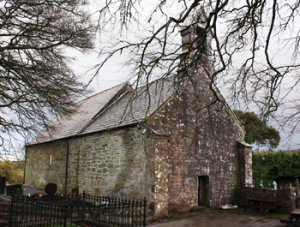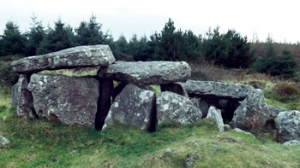Brian’s origins and the kingdom of North Munster
Published in Features, Issue 2 (March/April 2014), Volume 22![Brian Boru’s Fort, Killaloe, Co. Clare. In the Annals of the Four Masters Brian is identified as a member of the Uí Thoirdelbaig, whose territory was in the vicinity of Killaloe. (T. Blake and F. Reilly, Ancient Ireland—exploring Irish historic monuments [The Collins Press, 2013])](https://www.historyireland.com/wp-content/uploads/2014/03/Dal-Cás-territiory-r1DA98E-254x300.png)
In the early thirteenth-century Accallam na Senórach (‘Tales of the Elders of Ireland’) the ultimate ancestor of Brian Boru is said to have met his death in the parish of Galbally in east Limerick:
‘Cormac Cas [the Curly] son of Ailill Áulomm [Grazed Ear] attacked Eochaid Abratrúad [of the Red Eyelashes], the king of Ulster in the north. Eochaid died there and Cormac Cas was wounded and remained ill for 12 years. His brains were leaking but he held the kingship of Munster during this time. A stronghold and a fine residence were built for him at Dún ar Sléib [fortress on the mountain]. This mountain had a clear and pleasant natural well in its foundations and a great royal dwelling was built for him around it. Three stone pillars were erected around this well and the king’s bed was placed within them, with its head to the east. A trusted household warrior kept bathing his wound with water from a cup or a basin. He died there afterwards and was buried in a vault under the fortress. For this reason it is also called Dún Trí Liacc [the fortress of the three stones, Duntryleague].’
![Brian Boru’s Fort, Killaloe, Co. Clare. In the Annals of the Four Masters Brian is identified as a member of the Uí Thoirdelbaig, whose territory was in the vicinity of Killaloe. (T. Blake and F. Reilly, Ancient Ireland—exploring Irish historic monuments [The Collins Press, 2013])](https://www.historyireland.com/wp-content/uploads/2014/03/p48-Brian-Boru-Fort-300x198.png)
Brian Boru’s Fort, Killaloe, Co. Clare. In the Annals of the Four Masters Brian is identified as a member of the Uí Thoirdelbaig, whose territory was in the vicinity of Killaloe. (T. Blake and F. Reilly, Ancient Ireland—exploring Irish historic monuments [The Collins Press, 2013])
The drama of the location of Cormac’s grave is not in doubt, and its political relevance, on the mountainous fault-line between the two great power blocks of eleventh- and twelfth-century Munster, is unquestionable: the Galtees mark the division between Thomond (Tuath-Mumu, North Munster) and Desmond (Deas-Mumu, South Munster). Whether we should see Duntryleague as part of the original Dál Cais home-land, however, is far more dubious. It is noteworthy, for example, that in our text Cormac is said to be the son of Ailill Áulomm, who got his name from an incident in which his ear was bitten by a woman from the síd mound at Knockainey, Co. Limerick, north-west of Duntryleague. Ailill’s eldest and most famous son was Eógan Mór, the great-great-grandfather of Conall Corc, founder of Cashel and ancestor of the Eóganacht dynasties who dominated the provincial kingship of Munster. These were based in homelands which included the lands around Cashel itself, Glanworth in north Cork and, to a rather lesser extent, the area around Knockainey. Eógan was also remembered by the medieval genealogists as the ancestor of the Uí Fidgente, whose royal fort was located at Bruree, on the banks of the Maigue River, immediately to the east of Kilmallock. Thus it is Eógan’s descendants and not those of his putative brother, Cormac Cas, whose families ruled the flat lands of east Limerick and Tipperary.
Thomond and the Shannon

Tuamgraney church, Co. Clare. The first king of the Dál Cais, whose death is noticed under the year 934, was also abbot of Tuamgraney, while Brian’s mother, like many of the Tuamgraney abbots, came from the kingdom of Uí Fhiachrach Aidne, around Kilmacduagh in south Galway. (Tomás Ó Carragáin)
In contrast to the evidence for the descendants of Ailill Áulomm, our earliest references to the men of Thomond associate them firmly with the River Shannon. One such occurs in the vernacular life of Patrick, Bethu Phátraic, compiled from earlier materials in the tenth century just as the Dál Cais were coming into political prominence. Here we read:
‘The men of Tuath-mumu, to the north of Luimnech, went southwards in sea-fleets [mur-coblaig] to meet Patrick at Domnach Mór Maige Aine, that is to say, at what then and is now called Dún nÓacfhéne. He baptised them in Tír Glass to the south-east. Patrick afterwards went into Fininne, to the north-west of Domnach Mór, a hill from which is seen the country to the north of Luimnech. And he bestowed a blessing on the people of Tuath-mumu for the willingness with which they had come with abundance of their gifts to meet Patrick.’
The association between Thomond, the use of shipping and control of the River Shannon above modern Limerick could hardly be made clearer. It is reinforced yet again by the entry in the Annals of Inisfallen in 963: ‘A slaughter of the Tuad Mumu on the Shannon, and they abandoned their vessels and were drowned’. This is also the area where we can trace Brian’s immediate antecedents. In the genealogies, for example, Brian is identified as a member of the Uí Thoirdelbaig, whose territory was located in the vicinity of Killaloe in the Annals of the Four Masters under the year 1192. St Flannan, whose church was also located at Killaloe, is an ancestral member of the same dynasty. Brian Boru’s brother Marcán, at the time of his death, was leader of church communities at Killaloe, Terryglass and Inis Cealtra—clearly positioned to dominate the southern, northern and western areas of Lough Derg. Brian’s own settlement at Ceann Coradh (‘head of the weir’) seems clearly to reflect its position at the point where the Shannon exits Lough Derg and where a bridge, first documented in 1071, seems to have already existed in Brian’s own day (if we are to believe the topographical details given in the early twelfth-century Cogadh). The first king of the Dál Cais, a man whose death is noticed under the year 934, was also abbot of Tuamgraney, while Brian’s mother, like many of the Tuamgraney abbots, came from the kingdom of Uí Fhiachrach Aidne, around Kilmacduagh in south Galway. Brian’s immediate antecedents, in short, are all closely associated with the eastern shores of Lough Derg in County Clare, lying far to the north of Duntryleague and the Galtees.
Luimnech

The remains of a Neolithic passage tomb, known locally as Darby’s Bed, on Duntryleague Hill, north of the Galtee Mountains, close to where Cormac Cas, Brian Boru’s ancestor, was buried. Is it a coincidence that it was on the political fault-line between two power blocks, Thomond and Desmond? (Cathy Swift)
This location indicates that, as the Dál Cais grew in power in the first half of the tenth century, their most obvious enemies must always have been the Scandinavians of Luimnech. The exact significance of this word is debated and it appears, at this early date, to have been used of the estuary, while the core of the area we now call Limerick city was known as Inis Sibtonn (modern King’s Island). Apart from the defensive qualities of the island, cut off from the mainland by the Abbey River, Inis Sibtonn marks an important transition point in the navigation of the Shannon, for the stretch of water opposite the island contains the Curragower Falls and all shipping moving upriver must portage around this section. It is not surprising, therefore, that the island became the centre for a Viking base which, by the time Caithréim Chellacháin Chaisil was written in the first third of the twelfth century, could be termed a baile, containing multiple houses and surrounded by a city wall marked by towers and gateways. A contemporary description in the Metrical Dindshenchas classifies it further as an assembly area for warriors and wealthy merchants.
We know of at least one Scandinavian fleet based in the estuary in the mid-ninth century, when a candidate for leadership at Armagh, circuiting Ireland in what appears to have been a bid for resources, was captured in 845 and brought for ransom to the ‘ships at Luimnech’. With the resumption of Norse attacks in the early tenth century, Luimnech became the stronghold of Jarl Thórir Helgason, who used the Shannon as his highway into the interior. In 922, for example, the Annals of Inisfallen record:
‘Tomrair, son of Elgi, a Jarl of the foreigners on Luimnech and he proceeded and plundered Inis Cealtra and Muckinish and burned Clonmacnoise and he went on Lough Ree and plundered all its islands and he ravaged Mide [Westmeath and Meath]’.
Luimnech was so important in this era that it attracted the jealous attention of Dubliners, for in 924 the Annals of Ulster note that ‘Gothfrith, grandson of Ímar, made an expedition from Áth Cliath to Luimnech and a very large company of his followers were left behind with Elgi’s son’. Unfortunately we have no surviving accounts of the impact of such battles on the neighbouring Dál Cais of Killaloe but it is inconceivable that the militarisation of the area did not have an impact on the Claremen. At Cooperhill, west of Limerick city, a ‘type D’ sword of pre-tenth-century date was found in the Shannon mud, while an Anglo-Saxon sword with a decorated pommel was found at Askeaton. At Cahercommaun in north Clare, ‘type 1’ arrowheads similar to those found at Dublin and York have been dated to the first half of the tenth century.
Conclusion
What, then, is the origin of the tradition that Cormac Cas was buried at Duntryleague? It is clear that Mathgamain and his younger brother Brian fought extensively in the lands to the south. In 964 Mathgamain conquered Cashel, and in 967 he and his brother fought the battle of Sulchoit or Sulloghodmore (outside Limerick Junction) prior to their attack on the Viking base of Limerick. In 976 Mathgamain was seized by Donnubán son of Cathal, the Uí Fidgente king of Bruree, and handed over to Máel Muad of Desmond to be killed. After this period, however, Brian and his descendants appear to have largely dominated Munster north of the Galtees. The genealogists, whether patronised by Dál Cais or Eóganacht kings, recognised the reality of this situation. By 1100, if not earlier, the doctrine of Cormac Cas as younger son of Ailill Áulomm appears in our records and the kingship of Munster is said to alternate between his descendants and those of his brother Eógan Mór. It is probably in this post-tenth-century era, then, that Cormac Cas was first said to have been buried in Duntryleague.
Catherine Swift is head of Irish Studies in Mary Immaculate College, Limerick.
Further reading
A. Dooley & H. Roe, Tales of the Elders of Ireland (Oxford, 2008).
D.B. Jaski, ‘The genealogical section of the Psalter of Cashel’, Peritia 17–18 (2003–4), 295–337.
M. Ní Mhaonaigh, Brian Boru: Ireland’s greatest king (Cambridge, 2006).
D. Sproule, ‘Politics and pure narrative in the stories about Corc of Cashel’, Ériu 36 (1985), 11–28.
















